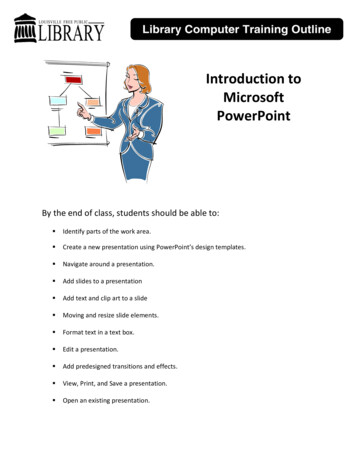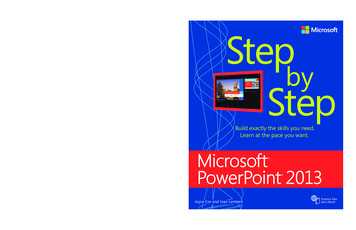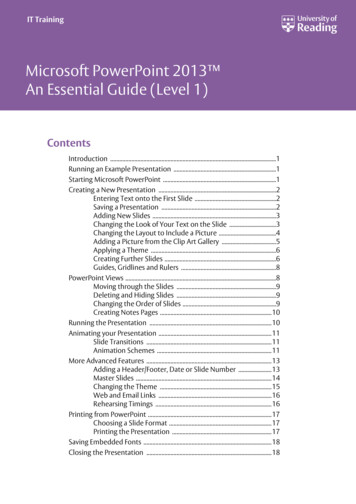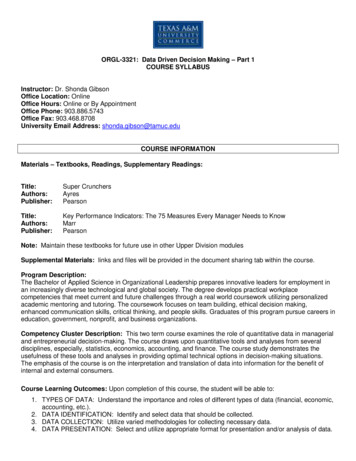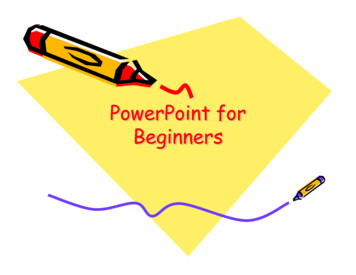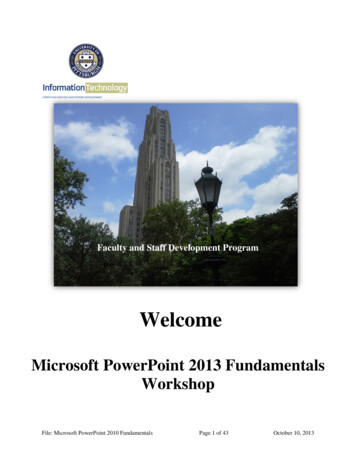
Transcription
Faculty and Staff Development ProgramWelcomeMicrosoft PowerPoint 2013 FundamentalsWorkshopFile: Microsoft PowerPoint 2010 FundamentalsPage 1 of 43October 10, 2013
Technology Help Desk412 624-HELP [4357]technology.pitt.eduMicrosoft PowerPoint 2013 Fundamentals WorkshopOverviewMicrosoft PowerPoint 2013 is a presentation application that enables an individual from any technical levelto create a dynamic and professional-looking presentation. This is a hands-on workshop to help Universityof Pittsburgh faculty and staff with the fundamental features of PowerPoint and will teach them how todevelop a slide presentation that will engage and inform an audience. Topics covered include: Learn about the new Ribbon interface in PowerPoint 2013Learn how to create slides, use Themes, and apply color schemesMaster how to format text, colors, and bulletsCreate maximum impact slides by inserting and editing pictures in your slidesLearn how to include transition and animation effectsOrganize and manage your slides using PowerPoint’s View optionsTable of ContentsI.Introductiona. Launch PowerPointb. Windows Featuresc. Feature Terms and Descriptionsd. Presentation Slides4II.Create Slide Presentationa. Design Themeb. Add Textc. Add New Slide8III.Editing Techniquesa. View Modesb. Edit Bulleted Listc. Add Clip Art13IV.Slide Mastera. Edit Slide Master17V.Format Slidea. Replace Fontb. Format Textc. Format Placeholderd. Change Bulletse. Change Themef. Modify Themeg. Add Footer19File: Microsoft PowerPoint 2010 FundamentalsPage 2 of 43October 10, 2013
VI.Transition and Animationa. Slide Transitionb. Text Animationc. Custom Filter26VII.Slide Illustrations and Shapesa. Illustration Featuresb. Create Shapes29VIII.Slide Showa. Launch Slide Showb. Navigation Slide Show32IX.Print Presentationa. Printb. Sample Output34X.Exit PowerPoint 201338XI.Individual Exercise38XII.Referencea. Hide Slideb. Set Automatic Timingc. Working with an Image39File: Microsoft PowerPoint 2010 FundamentalsPage 3 of 43October 10, 2013
I.IntroductionMicrosoft PowerPoint is a robust application that allows you to combine text, graphics, andpredesigned backgrounds to create professional presentations. The following is an illustration inhow to launch PowerPoint for the first time user.A.Launch Microsoft PowerPoint 2013To launch PowerPoint for the first time:1.Click on the Start button.2.Click on All Programs, select Microsoft Office from the menu options, and then click onMicrosoft PowerPoint 2013.Note: After PowerPoint has been launched for the first time, the PowerPointicon will belocated on the Quick Launch pane. This enables you to just click on the Start button and thenclick on the PowerPoint icon to launch PowerPoint. Also, a shortcut for PowerPoint can becreated on your desktop.File: Microsoft PowerPoint 2010 FundamentalsPage 4 of 43October 10, 2013
B.Windows FeaturesThe purpose of Windows Features is to enable the user to perform routine tasks related to theMicrosoft applications. All Office applications share a common appearance and similar features.Windows Features provide a quick means to execute commands. Below are some pertinentPowerPoint features:1. Quick Access Toolbar2. Title Bar3. File Tab8. Ribbon4. Thumbnail Slide9. Collapse5. Title Placeholder6. Subtitle Placeholder10. Work Area7. Status BarFile: Microsoft PowerPoint 2010 Fundamentals11. View OptionsPage 5 of 43October 10, 2013
C.Feature Terms and DescriptionsTermDescription1Quick Access Toolbar Displays quick access to commonly used commands.2Title BarDisplays the name of the open file.3File TabThe File tab has replaced the Office 2007 button. It helps you to managethe Microsoft application and provides access to options such as Open,New, Save As, Print, etc.4Thumbnail SlideDisplays a snapshot of each slide.5Title PlaceholderSection where text is entered.6Subtitle PlaceholderSection where text and/or graphics are entered.7Status BarDisplays information about the slide presentation, such as page numbers.8RibbonDisplays groups of related commands within tabs. Each tab providesbuttons for commands.9Collapse10Work Area11View OptionCollapses the ribbon so only the tab names show.Each slide has an area where text and graphics are entered for apresentation. There are various slide layouts to work from.Displays several View modes for slides.File: Microsoft PowerPoint 2010 FundamentalsPage 6 of 43October 10, 2013
D.Presentation SlidesSlides in a presentation are similar to pages in a word processing document. All slides and graphicsare saved in one file (example: keys.xppt). Use the PowerPoint file to present the information inthe following ways: On-screen slide show: The keys.xppt file displays the slide show on a monitor or computerprojected large screen. Web pages: The keys.xppt file can be saved as Web page and then published on the Web. Overhead transparencies: The keys.xppt file can be printed as transparencies (Important:Make sure the appropriate transparencies are used for your printer model. The wrong type oftransparencies can melt inside your printer.). Handouts: The keys.xppt file can print two to nine mini slides per page.File: Microsoft PowerPoint 2010 FundamentalsPage 7 of 43October 10, 2013
II.Create Slide PresentationThis section will teach the basics of opening PowerPoint and beginning a presentation.When PowerPoint is launched the Presentation window will appear.When creating a new presentation, you have choices about how to proceed. PowerPoint gives youa range of ways with which to start creating a presentation. You can start your presentation with: Blank: Slides that are unformatted and have no color scheme.Design: Slide Themes that have design concepts, fonts, and color schemes.Template on Microsoft.com: Microsoft Office Templates and Theme Gallery which arearranged according to type (Click on the File tab, select the New option, and then click onPowerPoint presentations and slides from the Available Templates and Themes.).This workshop section will focus on using a Design Theme.File: Microsoft PowerPoint 2010 FundamentalsPage 8 of 43October 10, 2013
A.Design ThemeA Theme gives your slides a consistent appearance throughout your presentation. Themes containcolor schemes with custom formatting, styled fonts, and layouts. When you apply a designtemplate to your presentation, the slide master and color scheme of the template replaces theoriginal blank slide.1.Select the Design tab, then on the Theme group, click on the drop-down arrow next to thelast Theme.2.The All Themes window will appear with available presentation Themes.3.Hover the mouse pointer over a Theme to preview it.4.Click on a Theme of your choice.Note: You can change the Theme during or after the creation of your PowerPoint file.File: Microsoft PowerPoint 2010 FundamentalsPage 9 of 43October 10, 2013
B. Add TextThe template for the design Theme you select will determine the font type and text alignment.PowerPoint places all information (text and graphics) contained on a slide in separatePlaceholders. Placeholders are designated by dotted lines; they appear on a slide as guides, butthey will not appear on the finished presentation. In order to edit text, click once inside of the TextPlaceholder and the insertion point will appear; then begin to type your text.1.Click in the Title Placeholder and type the text title below.2.Click in the Subtitle Placeholder.3.Type the text below (You will need to press the Enter key after each line of text.).4.Save the presentation. Click on the File tab and then click on Save As. The Save Aswindow will open. In the File name box, type Keys to Success for the presentation name.The instructor will indicate where to save the file. Click on the Save button.File: Microsoft PowerPoint 2010 FundamentalsPage 10 of 43October 10, 2013
C. Add New SlideA slide layout defines the placement of text, pictures, tables, and graphs. If you change the layoutof a slide, the text and graphics remain intact. You can resize text and graphic boxes to conform tothe new layout.1.On the Home ribbon, located in the Slides group, click on the New Slide drop-down arrow.The Office Theme panel will appear with multiple slide layouts. Select your desired slidelayout.2.For this exercise, click on the second Layout (Title and Content) in the first row.3.In the Title Placeholder, type the text Agenda as seen above.4.In the Text Placeholder, type the bulleted text as seen above (You will need to press Enterafter each line of text.).5.Add another new slide.File: Microsoft PowerPoint 2010 FundamentalsPage 11 of 43October 10, 2013
6.On the Home ribbon, click on the New Slide drop-down arrow and then select the TwoContent slide layout (This slide contains a title, text, and clip art placeholders.).7.Click inside the Title and Text Placeholders and type the text shown above.8.On the Quick Access Toolbar, click on the Save button to save your presentation changes.File: Microsoft PowerPoint 2010 FundamentalsPage 12 of 43October 10, 2013
III.Editing TechniquesThis section will teach you basic techniques for editing slides.A.View Modes for EditingThe Normal, Slide Sorter, Reading, and Slide Show Views allow you to type, edit, and viewyour presentation. To switch between views, click the View Optionsbuttons atthe lower right-hand side of the PowerPoint window.Normal ViewNormal View is the main editing View, which you use towrite and design your presentation. The View has threeworking areas: on the left, tabs that alternate between anoutline of your slide text (Outline tab), and your slidesdisplayed as thumbnails (Slides tab); on the right, theslide pane, which displays a large view of the currentslide; and on the bottom, the notes pane.Slide Sorter ViewSlide Sorter View is an exclusive view of your slides inthumbnail form. When you are finished creating andediting your presentation, Slide Sorter gives you anoverall picture of it — making it easy to reorder, add, ordelete slides, and preview your transition and animationeffects.Reading ViewReading View is new in PowerPoint 2013. It is similar toSlide Show View. The difference between the two Viewsis that while Slide Show View takes over the wholescreen, the slide in Reading View is shown in full screen,but you will see the PowerPoint title band at the top ofthe screen. The PowerPoint status bar and the Windowstask bar are also displayed at the bottom of the screen.Slide Show ViewSlide Show View takes up the full computer screen, likean actual slide show presentation. In this full-screenView, you see your presentation the way your audiencewill. You can see how your graphics, timings, movies,transition effects, and animation elements will look in theactual show.File: Microsoft PowerPoint 2010 FundamentalsPage 13 of 43October 10, 2013
B.Edit Bulleted ListTyping text in PowerPoint is similar to typing in other applications. However, since PowerPointdeals with bulleted lists, a few keystrokes will be identified to help in typing multiple lines.1.Confirm you are on slide three.2.In Normal View, edit the bulleted list to include the circled text above. Place the Insertionbar after each line of the bulleted text and then press the Enter key.3.To add a sub-bullet, click on the Increase Indent button, located on the Home ribbon.The Tab key can also be used to indent text.4.Type the text and if additional sub-bullets lines are needed press the Enter key, after yourline of text.Note: Pressing Enter after any text returns the cursor to the same indent (paragraph) level for thenext line. The Tab key is also used before typing to indent text to the next indent level (sub-bulletpoint) and pressing Shift Tab before typing to return to the previous indent level.File: Microsoft PowerPoint 2010 FundamentalsPage 14 of 43October 10, 2013
C.Add PicturesOnline Pictures are any type of computerized images such as artwork and photos. You can makeyour presentation more eye-catching and entertaining by adding Pictures.1.Confirm you are on slide three.2.Click on the Online Picture button in the Illustration box, located in the TextPlaceholder.3.The Bing Image Search window will appear.File: Microsoft PowerPoint 2010 FundamentalsPage 15 of 43October 10, 2013
4.In the Search box, type the word Classroom, and then press the Enter key.A variety of online images associated with your search will appear.5.Scroll through the Pictures window to find your desired image.6.To insert the image, place the mouse pointer on the image and then click on the left mousebutton twice.Note: When the Illustration box does not appear on a slide, images can still be inserted byselecting the Insert ribbon and then click on the Online Pictures button.File: Microsoft PowerPoint 2010 FundamentalsPage 16 of 43October 10, 2013
IV.Slide MastersPowerPoint has a set of Master Slides available for every Design Theme. The three Mastersinclude a Slide Master, Handout Master, and Notes Master. Masters correspond directly to theslides. Masters contain the elements that appear on every slide and control the format for all slidesin a presentation, which provides a consistent appearance for each slide.A.Edit Slide MasterThe Slide Master View is located on the View ribbon. This exercise will demonstrate how tomodify a Slide Master which will affect your entire presentation.1.Change to Slide Master View by selecting the View ribbon. Click on the Slide Masterbutton, located in the Master View group as shown above.File: Microsoft PowerPoint 2010 FundamentalsPage 17 of 43October 10, 2013
2.Click on the Master Title Style placeholder border. This will activate the entire title area.3.Select the Home tab and then click on the Font show dialog box.4.The Font window will appear.5.Confirm that the Font tab is active.6.In the Latin text font box, change to a different Font type.7.In the Font color box, change to a different color.8.Click on the OK button.File: Microsoft PowerPoint 2010 FundamentalsPage 18 of 43October 10, 2013
9.Select the View ribbon tab and then click on the Normal button in the Presentation Viewsgroup.10.Scroll through the slides to see how the font and color changes made in the Slide Masterhave affected the entire presentation.Note: Changes you make to the Slide Master will affect all slides in your presentation.V.Format SlideYou can change the format appearance of text and slides in the Slide View as well. Formatting canbe applied to all slides at the same time as in the Master View or only on an individual slide.A.Replace FontUse the Replace command to change the font throughout a presentation.1.Go to slide two.2.Click on the Text Placeholder (bulleted list) border.3.On the Home ribbon, click on the drop-down arrow next to the Replace button, located inthe Editing group, and then select the Replace Font option.4.The Replace Font window will appear.File: Microsoft PowerPoint 2010 FundamentalsPage 19 of 43October 10, 2013
5.In the Replace box, click on the drop-down arrow and select the Font you want to replace.6.In the With box, click on the drop-down arrow and select the desired Font.7.Click on the Replace button to change all slides.8.Click on the Close button.9.View your change.B.Format TextText appears on each slide in a format consistent with the template. You can add or change anytext attribute such as bold or italics on any given slide by making the change on the slide. TheFont button commands are located on the Home ribbon in the Font group.1.Go to slide one.2.Select the Title Placeholder, and click on the Italic3.Use the Font Size4.Go to the next slide. Notice that the title text on this slide has not been affected.5.Go to slide two, click on the Font Colordifferent color.button in the Font group.button to change the point size to a higher number.File: Microsoft PowerPoint 2010 Fundamentalsbutton, located in the Font group, to select aPage 20 of 43October 10, 2013
C.Format PlaceholderYou can resize or add color and lines to a placeholder, as well as changing the text to a differentstyle and color.1.On slide two, select the Text Placeholder.2.On the Drawing Tools ribbon, click on the Format tab. View the different formattingoptions within the groups.3.In this exercise the instructor will guide you through several formatting options for yourplaceholder.D.Change BulletsPowerPoint allows you to change the style, color, and size of bullets. You can apply the new bulletstyle to a single bullet, a bulleted list, or for an entire presentation. To change a single bullet, clickthe cursor anywhere in the line corresponding to the desired bullet. To change multiplebullets/lines, use the mouse to select the bulleted items you want to change, or select the TextPlaceholder to change all bullets within the placeholder.1.Go to slide three.2.Click anywhere in the first line of Computer-base training (CBT).File: Microsoft PowerPoint 2010 FundamentalsPage 21 of 43October 10, 2013
3.Select the Home tab, click on the drop-drop arrow next to the Bullets button.4.The Bullets panel will appear and then you have the option to select one of the bullet stylesthat appear.5.More bullet options are available by clicking on the Bullets and Numbering option,located at the bottom right-hand side of the window (On the Bullets and Numberingwindow, you have Bulleted and Numbered tab choices.).6.The Picture and Customize buttons will appear on the bottom of the Bullets andNumbering window.7.Clicking on the Picture button provides an array of picture bullets to select. Clicking onthe Customize button will allow you to choose a variety of Symbol windows with eachwindow having multiple symbols to select as bullet options.8.In this exercise you will select a square-shaped bullet style and then click OK.Note: To select a different color for bullets, use the Color drop-down list on the bottom of theBullets and Numbering window. The size of the bullet can be increased or decreased as well.Click the up or down arrows next to the Size box to select a new bullet size.File: Microsoft PowerPoint 2010 FundamentalsPage 22 of 43October 10, 2013
9.Notice the bullet changed only on line one.10.Change the bullet style for the remaining lines of text by selecting the desired indentedlines of text.11.Select the Home tab, click on the drop-drop arrow next to the Bullet button.12.The Bullet panel will appear.13.Click on a different bullet style or the same style on line one.E.Change ThemeYou have the option to change the slide Theme on one slide or an entire presentation. Hovering themouse pointer over the Theme will allow you the options of Apply to All Slides or Apply toSelected Slide.1.Change the slide Theme to your presentation. Select the Design ribbon and then click onthe drop-down arrow on the right-hand side of the last Theme thumb print row. MoreThemes will be previewed; select your desired Theme.File: Microsoft PowerPoint 2010 FundamentalsPage 23 of 43October 10, 2013
F.Modify ThemeYou have the option to change the Theme color, font, and background on your slides. Use theDesign ribbon to modify your presentation Theme.1.To change your slide Theme color scheme, click on the drop-down arrow next to the Colorbutton, located in the Themes group, and then select your desired color scheme.2.To change your slide Font, click on the drop-down arrow next to the Fonts button, locatedin the Themes group, and then select your desired Font options.3.To change your slide Background Color, click on the drop-down arrow next to theBackground Style button, located in the Background group, and then select your desiredbackground categories.(To remove a slide background graphic, select the Hide Background Graphics box.)G.Add FooterTo insert information in the slide Footer, select the Header and Footer button located on theInsert ribbon. Information such as the date and time, the slide number, and desired text can beinserted on the Footer of the slides.1.Select the Insert ribbon tab and then click on the Header and Footer button.File: Microsoft PowerPoint 2010 FundamentalsPage 24 of 43October 10, 2013
2.The Header and Footer window will appear.3.Confirm that the Slide tab is active.4.Select the Date and time box.5.Select the Fixed button and then type today’s date in the Fixed entry box.6.Select the Footer box and then type University of Pittsburgh in the Footer entry box.7.Click on the Apply to All button. This will enable all slides to have the new information.Note: Once you select Date and time, you must select either the Update automatically orFixed box.File: Microsoft PowerPoint 2010 FundamentalsPage 25 of 43October 10, 2013
VI.Transition and AnimationPowerPoint allows you to apply special effects by using slide transition and text/graphicalanimation to make your presentation more visually appealing.A.Slide TransitionTransitions are visual special effects that you see when you move from one slide to the next.Working in Normal or Slide Sorter Views allow you to set transitions for a slide. The Transitionribbon allows you to apply slide transitions.1.Go to slide one.2.Click on the Transition tab and then click on the drop-down arrow located in theTransition to This Slide group to view the transition categories as seen below.File: Microsoft PowerPoint 2010 FundamentalsPage 26 of 43October 10, 2013
3.In the Exciting selection, click on the Blinds button. The selected slide will demonstratethis effect as you make your choice. Click on the Preview button located on the Transitionribbon to demo the effect again.4.To apply your selection to all slides, click on the Apply to All button, located in theTiming group.5.Notice the transition indicatorNormal View.icon on the left-hand side of the thumb print slide inNote: You can also apply sound and timing speed to the selected transition from the Timing grouplocated on the Transition ribbon. Click on the drop-down arrow in the Sound box to choose asound. Click on the up or down arrow in the Duration box to set the timing on the transition.B.Text AnimationBulleted text animation refers to the progressive display of bulleted items. Bulleted items, bydefault, appear at the same time on a slide. When text animation is applied, bulleted list items canappear on the slide one at a time or can have motion as they display on the screen. Select theAnimation ribbon to apply animation to slide text.1.Confirm that you are in Normal View (View, Normal).2.Go to slide two.3.Click inside the Text Placeholder and select the text area.4.Click on the Animation tab and then click on the drop-down arrow located in theAnimation group to view the animation categories as seen above.File: Microsoft PowerPoint 2010 FundamentalsPage 27 of 43October 10, 2013
5.In the Entrance section, click on the Fade button.6.Notice the animation indicatorNormal View.7.Go to slide five, and select the Title Placeholder.8.Click on the Animation tab and then click on the drop-down arrow located in theAnimation group to view the animation categories.9.In the Entrance section, click on an animation of your choice.icon on the left-hand side of the thumb print slide inNote: You can apply timing to or delay the speed of the selected animation from the Timing grouplocated on the Animation ribbon. Click on the up or down arrow in the Duration or Delay box toset the timing or delay on the transition.File: Microsoft PowerPoint 2010 FundamentalsPage 28 of 43October 10, 2013
VII. Slide Illustrations and ShapesA.Illustration FeaturesMicrosoft Office has multiple Illustration and Image features to enhance your document withnumerous graphics, sound, and motion. PowerPoint allows you to insert Illustration and Imagefeatures such as Tables, Charts, SmartArt, Pictures, and Media Clips within the Text Placeholders.1.Click on an Illustration and Image button to locate, format, and insert features into yourslide (These features can also be located on the Insert ribbon.).2.The SmartArt is the newest feature in Microsoft Office. When you click on theSmartArtbutton, the Choose a SmartArt Graphic window will appear. You canenhance your slide presentation by incorporating text with a variety of images.File: Microsoft PowerPoint 2010 FundamentalsPage 29 of 43October 10, 2013
3.Go to slide three and then add a new Title and Content slide.4.In this exercise the instructor will guide you through the use of SmartArt and several otherIllustration features.B.Create ShapesSmartArt has numerous graphical options to select from, but you can also create your owngraphical slide by using Shapes. Select the Insert ribbon to view available shapes.1.Confirm slide four is selected and then add a new Blank Layout slide.2.The instructor will guide you through this exercise in creating shapes on the new slide thatis illustrated on the next page.File: Microsoft PowerPoint 2010 FundamentalsPage 30 of 43October 10, 2013
File: Microsoft PowerPoint 2010 FundamentalsPage 31 of 43October 10, 2013
VIII. Slide ShowOnce you are finished adding text, graphics, and formatting to a presentation, then you can run theSlide Show. PowerPoint allows you to preview, rehearse, or show your presentation electronicallyto an audience. Display the presentation on-screen by selecting the Slide Show ribbon.A.Launch Slide Show1.Select the Slide Show ribbon and then click on the From Beginning button. The SlideShow will begin with the first slide.Note: The Slide Show buttonthe current slide.B.on the Option Views bar will start the slide show beginning withNavigation Slide ShowWhen running your slide show, advance to the next slide by clicking with your mouse, pressing theright arrow on the keyboard, or pressing the Enter key. To return to the previous slide, press theleft arrow on the keyboard. To end the presentation, press the Esc key on the keyboard.You can use the following keyboard and mouse controls while running a slide show. Press the F1key during a presentation to display the dialog box below.File: Microsoft PowerPoint 2010 FundamentalsPage 32 of 43October 10, 2013
1.Navigate through the Slide Show by using some of the keyboard and mouse controls.2.Right-click with your mouse during the Slide Show and the menu below will appear;you can also use this to navigate through your slide show.Note: If you select Pointer Options, a pen icon will appear. You may then draw on a slideduring the presentation. The drawing that the pen creates will be erased as soon as the next slideis displayed or you press the letter E on the keyboard to erase the drawing.To return to the mouse pointer again, right-click, choose Pointer Options, and then click on theArrow option.File: Microsoft PowerPoint 2010 FundamentalsPage 33 of 43October 10, 2013
IX.Print PresentationUse the File tab and Print option to print your presentation in slides, outlines, speaker’s notes, andaudience handouts. Slides will be printed in full color (on a color printer) or in grayscale (on ablack and white printer). A PowerPoint presentation can also be printed on transparencies(Important: Make sure the appropriate transparencies are used for your printer model. The wrongtype of transparencies can melt inside your printer.).A.Print1.Click on the File tab and then select the Print option.2.The print Settings and Preview screen will appear.3.In the Print All Slides area, you have the option to print all slides or determine whichslides to print.4.After selecting your print Settings, click on the Print button.File: Microsoft PowerPoint 2010 FundamentalsPage 34 of 43October 10, 2013
B.Sample Output1.Presentation OutlineIn the Full Page Slides section, select the Outline option. Your presentation outline will previewbefore you print. Notice that graphics don’t display on the outline.File: Microsoft PowerPoint 2010 FundamentalsPage 35 of 43October 10, 2013
2.Presentation Speaker’s NotesIn the Full Page Slides section, select the Notes Pages option. Your speaker’s notes will previewbefore you print.File: Microsoft PowerPoint 2010 FundamentalsPage 36 of 43October 10, 2013
3.Presentation Audience HandoutIn the Full Page Slides section, select the number of slides per page (3 Slides) option. You canselect from one to nine slides per page. The slides per page will preview before you print. Threeslides per page will place lines on the right-hand side of the slide. This is for audience notes.File: Microsoft PowerPoint 2010 FundamentalsPage 37 of 43October 10, 2013
X.Exit PowerPoint 2013To exit PowerPoint, select File and click on Exit or click on the closebutton in the upper righthand corner of your document. If you have made changes to your document and not saved them,then the Microsoft PowerPoint window will appear.1.Click on the Save button to save any changes you made, click on the Don’t Savebutton to abandon changes, or click on the Cancel button which will allow you to return toyour presentation work area.XI.Individual ExerciseBased on what you have learned from this workshop, create your own PowerPoint presentation, ona topic of your choice. Your presentation should contain at least five slides. The instructor will beavailable to assist you with new features learned and answer further questions.File: Microsoft PowerPoint 2010 FundamentalsPage 38 of 43October 10, 2013
XII. ReferenceA.Hide SlideHidden slides are excluded from an on-screen presentation. Slides can be hidden that are notpertinent to the presentation, but have valued information for your reference. This command canbe done in the Normal or Slide Sorter View mode.1.Select the slide to be hidden.2.Click on the Slide Show tab and then click on the Hide Slide button.3.Notice the Hidden Slide indicator on the left-hand side of the thumb print slide.4.To unhide slides, deselect the Hide Slide button.File: Microsoft PowerPoint 2010 FundamentalsPage 39 of 43October 10, 2013
B.Set Automatic TimingYou can set timing for each of your slides in a presentation, so that you do not have to manuallyadvance
Microsoft PowerPoint 2013 is a presentation application that enables an individual from any technical level to create a dynamic and professional-looking presentation. This is a hands-on workshop to help University . Microsoft Office Templates and Theme Gallery which are arranged accor
